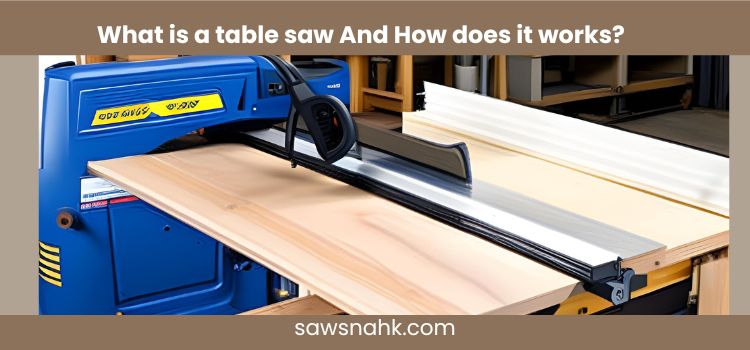What Is A Table Saw? And How Does It Work?

There’s a saying among woodworkers: “Know your tools as you would know your closest friends.” This holds especially true when it comes to the table saw, a crucial instrument in the diverse realm of woodworking.
The path to mastering this craft not only lies in honing your skills but also in developing an in-depth understanding of the tools at your disposal. This blog post aims to demystify the table saw, shedding light on its mechanism and the integral role it plays in woodworking.
What is a Table Saw?
Let’s begin by addressing the fundamental question: what exactly is a table saw? Picture a worktable, equipped with a sharp, circular blade jutting out from its center. This is your table saw, a versatile and essential woodworking tool.
Table saws are, primarily, used to make precise cuts in wood. Their application is widespread, ranging from simple tasks like cross-cutting and ripping to more complex operations like creating mitered corners and angled cuts. In the grand scheme of woodworking, the table saw’s value cannot be overstated. It is the quintessential tool that brings a blend of efficiency, precision, and versatility to any woodworking project.
Components of a Table Saw
To understand how a table saw works, it’s vital to familiarize ourselves with its key components. Broadly speaking, a table saw is made up of three main parts: the blade, the motor, and the table.
The Blade:
Serving as the heart and soul of the table saw, the blade is the part that does the actual cutting. It is a circular, serrated disc, typically made from robust materials like carbide-tipped steel or carbon steel.
The blade is designed to slice through wood effortlessly and accurately, making clean, precise cuts. Its height and angle can be adjusted to cater to various cutting requirements, thus offering a good deal of flexibility to woodworkers.
The Motor:
Acting as the force behind the blade is the motor. The motor is the powerhouse that drives the blade, causing it to spin at high speeds. The power output of the motor, often measured in horsepower, determines the table saw’s overall cutting power and the thickness of the wood it can handle.
The Table:
On the surface level, the table might seem like just a platform for the wood to rest on while cutting. However, its role extends beyond that. The table provides a steady and level surface for the woodworker to accurately feed the wood into the blade.
The quality and size of the table can significantly influence the accuracy and ease of cutting operations.
Each of these components contributes uniquely to the operation of the table saw, collectively ensuring that it functions efficiently and effectively.
How does a Table Saw Work?
Having covered what a table saw is and its key components, let’s delve into the working mechanism of this fascinating tool. The operation of a table saw is relatively straightforward, but it’s a marvel of mechanical design and engineering.
The process begins when the motor is switched on. The electrical energy is converted into mechanical energy, causing the motor to power up and spin the circular blade at high speeds.
As the blade begins to spin, it’s time to make the cut. The piece of wood (or other material) to be cut is placed on the table. The woodworker then carefully pushes the wood across the table and into the spinning blade. The sharp teeth of the blade tear into the wood, slicing it as desired.
Safety, naturally, is a significant concern when operating such a powerful tool. Modern table saws come equipped with numerous safety features designed to protect the user.
Some of these include a blade guard, which is a cover that prevents accidental contact with the spinning blade; a riving knife, which keeps the cut section of the wood from pinching the blade and causing a kickback; and anti-kickback pawls, which are sets of sharp, downward-facing teeth that prevent the wood from being flung back towards the user.
Conclusion
To sum it up, the table saw is a mighty tool in the realm of woodworking. It’s more than just a table with a spinning blade; it’s an ingenious piece of engineering designed to make woodworking more efficient, accurate, and versatile.
Understanding the nuances of this tool, from its main components to its working mechanism and safety features, is paramount for anyone involved in woodworking. So, whether you’re an amateur woodworker just starting or an experienced professional, continue to explore and learn about your tools, especially your table saw.
After all, knowledge is power, and in this case, it’s the power to create with precision and safety.
Can a beginner safely use a table saw?
Yes, a beginner can use a table saw safely. You must follow safety guidelines and wear the appropriate safety equipment. Use safety features such as blade guards and splitters. As you gain experience, start with simple tasks and progress to more complicated ones.
How frequently should I maintain my table saw?
Regular maintenance is essential for your table saw to perform optimally and last as long as possible. Before each use, it is recommended that you perform routine checks, including checking for blade damage, ensuring alignment, and making sure all safety features work correctly.
Can a table saw be used to cut materials other than wood?
Yes, you can use Table Saw to cut materials than wood. Table saws were designed primarily to cut wood. Although some blades are designed to cut plastics or non-ferrous materials, it is important that the motor and blade of the table saw are appropriate for the material.
